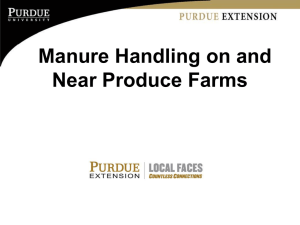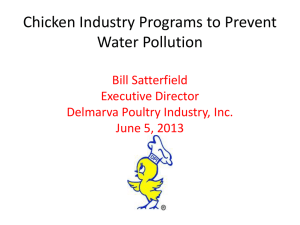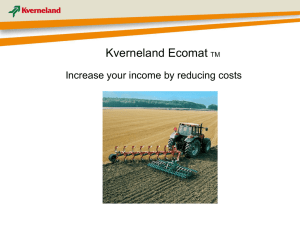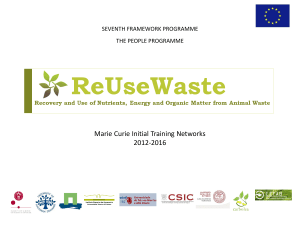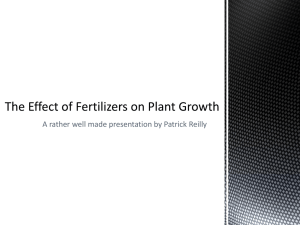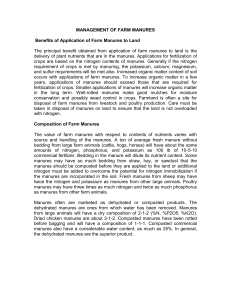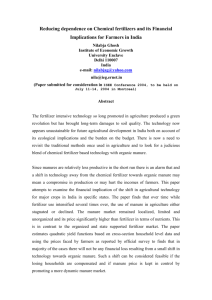Phosphorus Chemistry in Soils and Response to Fertilizer and
advertisement
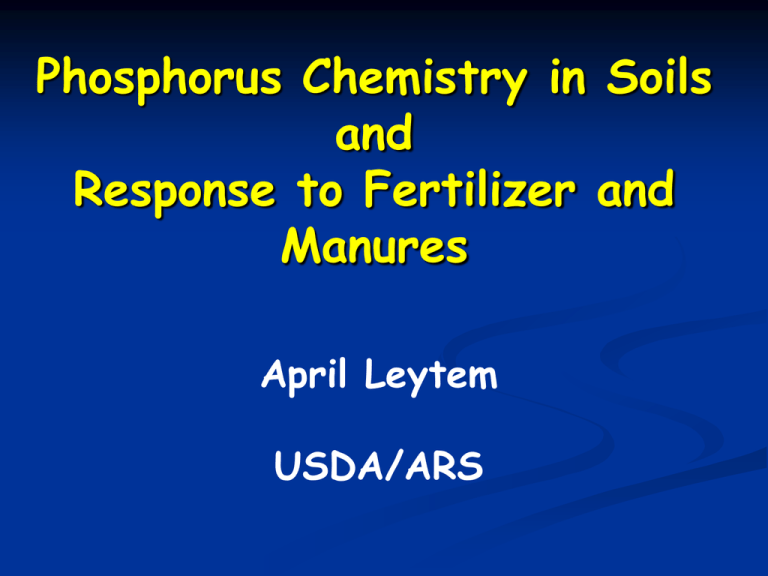
Phosphorus Chemistry in Soils and Response to Fertilizer and Manures April Leytem USDA/ARS The Phosphorus Cycle Crop harvest Animal manures and biosolids Component Inputs Outputs Atmospheric deposition Mineral fertilizers Plant residues Runoff and erosion Organic phosphorus •Microbial •Plant residue •Humus Plant uptake Soil solution phosphorus •HPO4-2 •H2PO4-1 Leaching Primary minerals (apatite) Dissolution Precipitation Mineral surfaces (clays, Fe and Al oxides, carbonates) Secondary compounds (CaP, FeP, MnP, AlP) PPI Facts About Calcareous Soils • Estimates of 800 million hectares of calcareous soils worldwide • Generally they are low in P due to fairly insoluble Ca-P minerals • The concentration of available P continues to decrease over time S oil P F ractions M in eral P ii S o lu tio n P ii & P oo L ab ile P ii & P oo M ineral P > > > L abile P > > S olution -P Phosphorus Sorption in Soils S o rb e d P (m mo l P k g -1 ) 100 Ex p e rim e n ta l D a ta F re u n d lich 80 P re cip ita tio n 60 40 20 0 0 200 400 600 -1 E q u ilib riu m P (mg P L ) 8 00 Calcite Equilibrated for 10 Days 0 ppm P Calcite Equilibrated for 10 Days 10 ppm P Calcite Equilibrated for 10 Days 50 ppm P The quantity of P sorbed on calcite depends largely on its surface area Pure calcite has low surface area (1 to 2 m2/g) Soil calcite has surface area ranging from 16 to 200 m2/g (due to ongoing dissolution, reprecipitation, and incorporation of impurities) On pure calcite, sorption occurs on ~5% of the surface before adsorption clusters serve as nuclei for Ca-P precipitation Traditional Concepts Adding P Fertilizer to High pH/ High Calcium Soils • First few weeks, P initially precipitates as MCP…. Then DCPD • After 3 to 5 months, octacalcium phosphate precipitates • After 8 to 10 months, tricalcium phosphate forms • Long periods (years) hydroxyapatite minerals form… (mineral with lowest solubility controls P concentration- while intermediates are unlikely to persist) (Fraction of Added P Still Extractable) Fertilizer P Availability Phosphorus Availability Decreases Over Time Average of 44% P sorption between 30 and 180 days following application Incubation Period (days) (Sharpley et al., 1989) lbs P Rate,lbs PP O55/A /A Rate, P22O Soil Test Calibration Studies 500 P ot a t o P R e c om m e nda t i ons 400 300 12% Lime 200 100 0 Lime 0 0 UI, 2001 10 20 STPC 30 40 Soil Test Correlation Studies R elat ive Y ield R esp o nse, Po t at o es Relative Yield, % 120 100 0 Lime 80 60 12% Lime 40 20 0 0 10 20 STPC 30 40 University of Idaho: Potato P Recommendations take into account the free lime content of the soil Majority of the soils had a break-point at approx. 150 ppm. Sorbed P (mmol P kg-1) 90 60 30 0 0 200 400 600 800 0 200 400 600 800 90 60 30 low P (<150 ppm), P sorption with oxides, clay surfaces, and organicallycomplexed metals (Fe & Mn) 0 Equilibrium P (mg P L-1) high P (>150 ppm), precipitation reactions Leytem and Westermann, 2003 Organically complexed Mn and Fe were the primary factors controlling P sorption Xt, mmol P kg-1 40 30 20 10 r2 = 0.86 0 0 300 600 900 1200 1500 NTA (Mn + Fe), mmol kg-1 Leytem and Westermann, 2003 Phosphorus Sorption in Soils S o rb e d P (m mo l P k g -1 ) 100 Ex p e rim e n ta l D a ta F re u n d lich 80 P re cip ita tio n 60 40 20 0 0 200 400 600 -1 E q u ilib riu m P (mg P L ) 8 00 How Can organically complexed metals affect P adsorption? P is complexed with OM through metal bridges? PO4 • OM interferes with Ca-P and metal oxide precipitation by coating the calcite surfaces? Robbins and Westermann previously showed that organic carbon enhanced the solubility and extractability of added P in calcareous soilsshowing that there are many mechanisms regulating P sorption and solubility Organic Matter and P Interactions Organic ligands affect P sorption- they compete with orthoP for similar sites on the surface of oxides. Organic matter may also chelate metals and prevent reactions between metals and P How does this relate to Humic Acid additions? Far West Fertilizer Meeting, 2004: “Never add P fertilizer to a Calcareous soil without adding Humic Acid with it” University of Idaho experience with Humic Acid (2003 report) If Organically Complexed Metals Control P Solubility, What Happens When We Add Manure? Myths About P and Manures • Manure P is organic P • Organic P is more soluble and more readily leached than inorganic P • Manure is a greater threat to water quality than fertilizer P because it is organic P Some Typical Organic P Compounds in Manures OPO3H2 Organic P OPO3H2 OPO3H2 H2O3PO H2O3PO OPO3H2 Phytic Acid ATP (monoester) OH Inorganic P HO P OH OH O Inorganic Orthophosphate HO P O OH O P O Pyrophosphate OH P Sorption in Soils 500 -1 P Sorbed (mg P kg) 600 400 300 Phytic Acid 200 ATP ADP 100 AMP OrthoP 0 0 50 100 150 Equilibrium P (mg P mL-1) 200 Some Typical Organic P Compounds in Manures OPO3H2 Organic P OPO3H2 OPO3H2 H2O3PO H2O3PO OPO3H2 Phytic Acid ATP (monoester) OH Inorganic P HO P OH OH O Inorganic Orthophosphate HO P O OH O P O Pyrophosphate OH Manure P Composition 120% OrthoP Monoesters PyroP Phytic Acid 100% 80% 60% 40% 20% 0% SL SS-HP DL BS-grass DC PL How does manure behave as a fertilizer compared to inorganic fertilizer? Response Soil Testin P STP and Plant Growth 100 75 50 25 0 BS DC DL POLYP MAP MCP 5 Dry matter (g) RPE Olsen P 125 4 3 2 1 0 C BS MCP DL DC MAP POLYP (Leytem & Westermann, 2005) Plant P Uptake P uptake (mg) 10 8 6 4 2 0 C BS MCP DC MAP DL POLYP Although the soil test P increased less when we applied manures…. The amount of P taken up by the plants was greater for some manures than fertilizers Phosphorus Uptake Efficiency P Source RPE Olsen RP Efficiency Uptake Dairy Liquid 62.6 113.1 1.8 Beef Solid 26.5 59.5 2.24 Dairy Compost 49.0 149.9 3.05 MCP 100.0 100.0 1.0 MAP 85.3 145.0 1.69 Do these trends change in the field? Olsen P with Depth in Field Plots Olsen P (ppm) 40 a 30 a a b b Control Compost Manure Fertilizer 20 b 10 c c a ab ab b 0 0-6" 6-12" 12-18" Fertilizer and manure behave similarly in the topsoil, but fertilizer P enriched STP in the subsurface compared to manure and compost Runoff P from Field Plots 200 150 100 Control Compost Manure Fertilizer bc ab a Fertilizer and manure had similar runoff P while compost and control were lower but similar c 50 0 250 Cumulative runoff P was closely correlated with the bicarbonate STP Runoff P (mg) Runoff P (mg) 250 200 150 100 2 r = 0.82 50 0 0 10 20 Olsen P (ppm) 30 40 P Uptake from Field Plots Control Compost P uptake (kg) 30 Manure a a a Fertilizer 20 b 10 0 The addition of fertilizer, manure and compost increased the P uptake by the crop, but they did not differ significantly STP over 20 ppm does not require fertilizer addition Is it really all just about the P in manures or is there something else going on? 13C NMR of WS-Carbon Solid manures dominated by aromatic and aliphatic compounds (larger more stable) Dairy Compost 150 100 50 0 Dairy Manure 150 Liquid manures dominated by carbonyl functional groups (smaller more reactive) 100 50 0 Dairy Liquid 150 100 C h e m ic a l s h ift (p p m ) 50 0 -1 Olsen P (mg kg ) The Carbon in Manures Influences the P solubility of the Soil 90 80 70 60 50 40 30 20 10 0 2 r = 0.90 0 50 100 C:P Ratio of Manures 150 Effect of Microbial P on WSP and Olsen P WSP mg kg-1 60 40 r2 = 0.71*** 20 0 Olsen P mg kg-1 60 r2 = 0.75*** 40 20 0 0 20 40 Microbial P mg kg-1 60 P Release Over Growing Season From Manure, Compost and Fertilizer RPE PRS probes 50 40 compost C:P = 15 manure C:P = 45 fertilizer C:P = 0 30 20 10 0 0 2 4 6 8 Weeks 10 12 14 Summary • Manure with similar P composition applied at same total P rates • Differences in P solubility dominated by the amount of C added with the manure treatment • Manures increase STP less than fertilizer treatments but have a greater plant P uptake than fertilizer Implications • We need to consider the amount of C in calcareous soils when determining P sorption/availability • When we make P risk assessments in calcareous soils with manure incorporation, we need to consider the effects of the C content and composition of manures • Microbial P has a large influence on soluble P and this needs to be further explored So Why the P Problems with Manures? N:P ratios don’t match up Overfeeding of P in animal operations Crops want a ratio of about 5:1 Manure ratios are typically closer to 2:1 Therefore when applying manure on an N based rate we are always over applying P Low P availability of feeds in monogastrics leads to P supplementation Dairies traditionally overfeed P for insurance Cost of transporting manures Over application of manures on sites closest to manure generation/storage Northwest Irrigation and Soils Research Laboratory Kimberly, Idaho USA


